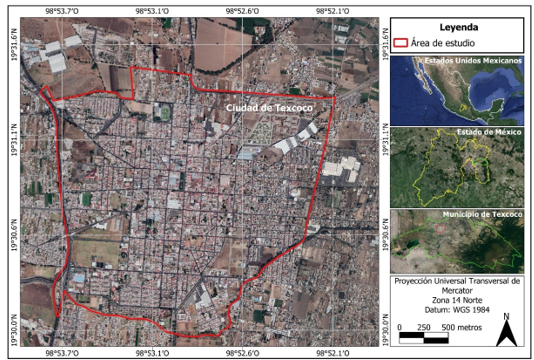The urban wasteland as alternative to create green areas in Texcoco, Mexico
Main Article Content
Abstract
Downloads
Article Details

This work is licensed under a Creative Commons Attribution-NonCommercial 4.0 International License.
References
BRUN, M., DI PIETRO, F. AND BONTHOUX S. 2017. Residents’ perceptions and valuations of urban wastelands are influenced by vegetation structure. Urban Forestry & Urban Greening, vol. 29, pp. 393-403.
CHEN, H., YANG, C., REN, A., GUO, K., FENG, X., LI, J., LIU, X., SUN, H. AND WANG, J. 2019. The evapotranspiration of Tamarix and its response to environmental factors in costal saline land of China. Water, Vol. 11. DOI: 0.3390/w11112273
EYHERABIDE, M., SAINZ, R.H., BARBIERI, P. AND EDUARDO, E.E. 2014. Comparison of methods for determining soil organic carbon. Ciencia Del Suelo (Argentina), vol. 32, no.1, pp. 13-19.
FLORES-XOLOCOTZI, R. 2017. Una reflexión teórica sobre estándares de áreas verdes empleados en la planeación urbana. Economía, Sociedad y Territorio, vol. 7, no. 54, pp. 491-522. DOI: 10.22136/est002017682
FREIRE, T.S. 2011. Los “vacíos urbanos”. Causas de su existencia en el suelo urbano de la primera periferia de Madrid. Revista Territorios en Formación, vol. 1, pp. 61-78.
GÁMEZ, B.V. 2005. Sobre sistemas, tipologías y estándares de áreas verdes en el planeamiento urbano. Revista Electrónica DU&P. Diseño Urbano y Paisaje, vol. 2, no. 6, pp. 1-22.
GONZÁLEZ-KUK, G., MUÑOZ-MÁRQUEZ, R.A., GARCÍA-ALBARADO, J.C. Y GÓMEZ-MERINO, F.C. 2019. Áreas verdes urbanas en Córdoba, Veracruz, cantidad, ubicación y acceso: análisis ortogonal. Revista Mexicana de Ciencias Agrícolas, vol. 10, no. 7, pp. 1565-1578.
GUILLAND, C., MARON, P.A., DAMAS, O. AND RANJARD, L. 2018. Biodiversity of urban soils for sustainable cities. Environmental Chemistry Letters, vol. 16, no. 4, pp. 1267-1282.
GUTIÉRREZ, C.M.C. Y ORTIZ, S.C.A. 1999. Origen y evolución de los suelos en el ex lago de Texcoco, México. Agrociencia, vol. 33, no. 2, pp. 200-208.
HANDLEY, J., PAULEIT, S., SLINN, P., LINDLEY, S., BAKER, A. AND JONES, C. 2003. Providing accessible natural green space in towns and cities. English Nature, vol. 1, pp. 1-6.
HERRERO, T.T.R., GÓMEZ-ELVIRA, G.M.A., PÉREZ, M.E. AND MARTÍN, R.J.L. 2006. Estudio de accesibilidad a las zonas verdes urbanas mediante sistemas de información geográfica. Universidad Politécnica de Madrid, España, vol. 1, pp. 1-12. Obtenido de: http://oa.upm.es/13529/
INSTITUTO NACIONAL DE ESTADÍSTICA Y GEOGRAFÍA (INEGI) (2020). En https://www.inegi.org.mx
MALEKI, S., REZAEE, A.A., HATAMI, D. AND JADIDOLESLAM, M. 2012. Investigation analysis and proposed per capita for urban Green space (case study) Darab city, Iran. Indian Journal of Innovations and Developments, vol. 1, no. 12, pp. 803-810.
MARTÍNEZ-VALDÉS, V., SILVA, R.E. Y GONZÁLEZ, G.E.J. 2020. Parques urbanos: un enfoque para su estudio como espacio público. Intersticios Sociales, vol. 10, no. 19, pp. 67-86.
NEJMAN, R., TEPKOWSKI, M., WILCZYNSKA, A. AND GAWRYSZEWSKA, B.J. 2018. The right to wild. Green urban wasteland in the context of urban planning. Urban Development Issues, vol. 59, pp. 43-53. DOI: 10.2478/udi-2018-0027
OSTOIC, S.K., KONIJNENDIJK, C.C., VULETIC, D., STEVANOV, M., ZIVOJINOVIC, I., MUTABDZIJA-BECIROVIC, S., LAZAREVIC, J., STOJANOVA, B., BLAGOJEVIC, D., STAJANOVSKA, M., NEVENIC, R. AND MALOVRH, S.P. 2017. Citizens’ perception of and satisfaction with urban forests and green space: Results from selected Southeast European cities. Urban Forestry & Urban Greening, vol. 23, pp. 93-103.
PÉREZ-MEDINA, S. Y LÓPEZ-FALFÁN, I. 2015. Áreas verdes y arbolado en Mérida, Yucatán. Hacia una sostenibilidad urbana. Economía, Sociedad y Territorio, vol. 15, no. 47, pp. 1-3.
R CORE TEAM. 2019. R: A language and environment for statistical computing. R Foundation for Statistical Computing, Vienna, Austria. URL https://www.R-project.org/.
REYES, P.S. Y FIGUEROA, A.I.M. 2010. Distribución, superficie y accesibilidad de las áreas verdes en Santiago de Chile. EURE, vol. 36, no. 109, pp. 89-110.
SAATY, T.L. 2013. Fundamental of decision and priority theory with the analytic hierarchy process. University of Pittsburgh, PA, USA.
SEGURA, C.M.A., GUTIÉRREZ, C.M.C., ORTIZ, S.C.A. Y GÓMEZ, D.D.J. 2000. Suelos arcillosos de la zona oriente del Estado de México. TERRA, vol. 18, no. 1.
SOSA-MARTÍNEZ, A., NARCHI, N.E., LEAL-BAUTISTA, R.M., FRAUSTO-MARTÍNEZ, O. Y CASAS-BELTRÁN, A. 2020. Percepción y uso del agua de lluvia por usuarios en una comunidad del Caribe mexicano. Sociedad y Ambiente, vol. 23, pp. 1-27.
SULTANI, B.K. 1995. Proposing a method for calculation of urban green space per capita. Abadi Magazine, vol. 5, no. 17.
TWERD, L. AND BANASZAK-CIBICKA, W. 2019. Wastelands: their attractiveness and importance for preserving the diversity of wild bees in urban areas. Journal of Insect Conservation, vol. 23, no. 3, pp. 573-588.
VILLALOBOS-BARQUERO, V. Y MEZA-MONTOYA, A. 2019. Impacto en la densidad aparente del suelo provocado por el tránsito de búfalos (Bubalus bubalis) en arrastre de madera. Tropical Journal of Environmental Science, vol. 53, no. 2, pp. 147-155. DOI: https://doi.org/10.15359/rca.53-2.8


